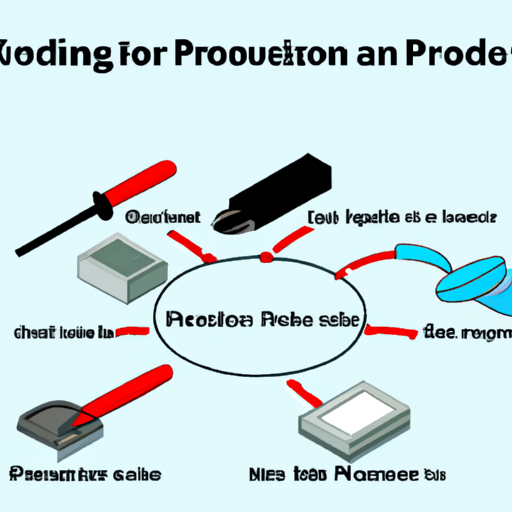Products
Products 

Information
Information 

Contact us 


Title: Common Production Processes for Probe Interface: A Comprehensive Overview

1. Design and Prototyping: The production process for probe interfaces typically begins with design and prototyping. Design engineers work closely with customers to understand their specific requirements and develop a design that meets their needs. Computer-aided design (CAD) software is often employed to create detailed 3D models, ensuring precise dimensions and functionality. Prototyping allows for testing and validation of the design before moving forward with mass production.
2. Material Selection: Choosing the right materials is crucial for probe interface production. Factors such as electrical conductivity, durability, and resistance to environmental conditions must be considered. Common materials used include various metals (e.g., stainless steel, copper, and aluminum), plastics (e.g., polytetrafluoroethylene), and ceramics. Material selection depends on the intended application, cost considerations, and specific performance requirements.
3. Manufacturing Processes: a. Machining: Machining processes, such as milling, turning, and drilling, are commonly employed to shape and refine the probe interface components. Computer numerical control (CNC) machines ensure high precision and repeatability. Machining is suitable for both metallic and non-metallic materials, allowing for intricate designs and tight tolerances.
b. Injection Molding: Injection molding is widely used for producing probe interface components made of plastics. This process involves injecting molten plastic into a mold cavity, which is then cooled and solidified. Injection molding offers high production rates, cost-effectiveness, and the ability to create complex shapes. It is particularly suitable for high-volume production.
c. Die Casting: Die casting is another popular manufacturing process for probe interfaces, especially those made of metals. Molten metal is injected into a die cavity under high pressure, resulting in a precise and detailed component. Die casting offers excellent dimensional accuracy, high production rates, and good surface finish. It is commonly used for producing probe interface housings and connectors.
d. Printed Circuit Board (PCB) Assembly: Many probe interfaces incorporate PCBs for signal processing and control. PCB assembly involves mounting electronic components onto the board, soldering them in place, and testing for functionality. Surface mount technology (SMT) and through-hole technology (THT) are the two primary methods used for PCB assembly. Automated assembly lines ensure efficient and reliable production.
4. Quality Control: Throughout the production process, rigorous quality control measures are implemented to ensure the probe interfaces meet the required standards. This includes inspections, functional testing, and dimensional checks. Advanced techniques such as coordinate measuring machines (CMM) and automated optical inspection (AOI) are employed to verify the accuracy and reliability of the components.
Conclusion: The production processes involved in manufacturing probe interfaces are diverse and require careful consideration of design, material selection, and manufacturing techniques. By understanding these processes, manufacturers can optimize their production lines, enhance product quality, and meet the ever-evolving demands of various industries. Continuous improvement and innovation in production processes will further drive the development of probe interfaces, enabling more accurate measurements, efficient data transfer, and improved control in a wide range of applications.
Title: Common Production Processes for Probe Interface: A Comprehensive Overview

1. Design and Prototyping: The production process for probe interfaces typically begins with design and prototyping. Design engineers work closely with customers to understand their specific requirements and develop a design that meets their needs. Computer-aided design (CAD) software is often employed to create detailed 3D models, ensuring precise dimensions and functionality. Prototyping allows for testing and validation of the design before moving forward with mass production.
2. Material Selection: Choosing the right materials is crucial for probe interface production. Factors such as electrical conductivity, durability, and resistance to environmental conditions must be considered. Common materials used include various metals (e.g., stainless steel, copper, and aluminum), plastics (e.g., polytetrafluoroethylene), and ceramics. Material selection depends on the intended application, cost considerations, and specific performance requirements.
3. Manufacturing Processes: a. Machining: Machining processes, such as milling, turning, and drilling, are commonly employed to shape and refine the probe interface components. Computer numerical control (CNC) machines ensure high precision and repeatability. Machining is suitable for both metallic and non-metallic materials, allowing for intricate designs and tight tolerances.
b. Injection Molding: Injection molding is widely used for producing probe interface components made of plastics. This process involves injecting molten plastic into a mold cavity, which is then cooled and solidified. Injection molding offers high production rates, cost-effectiveness, and the ability to create complex shapes. It is particularly suitable for high-volume production.
c. Die Casting: Die casting is another popular manufacturing process for probe interfaces, especially those made of metals. Molten metal is injected into a die cavity under high pressure, resulting in a precise and detailed component. Die casting offers excellent dimensional accuracy, high production rates, and good surface finish. It is commonly used for producing probe interface housings and connectors.
d. Printed Circuit Board (PCB) Assembly: Many probe interfaces incorporate PCBs for signal processing and control. PCB assembly involves mounting electronic components onto the board, soldering them in place, and testing for functionality. Surface mount technology (SMT) and through-hole technology (THT) are the two primary methods used for PCB assembly. Automated assembly lines ensure efficient and reliable production.
4. Quality Control: Throughout the production process, rigorous quality control measures are implemented to ensure the probe interfaces meet the required standards. This includes inspections, functional testing, and dimensional checks. Advanced techniques such as coordinate measuring machines (CMM) and automated optical inspection (AOI) are employed to verify the accuracy and reliability of the components.
Conclusion: The production processes involved in manufacturing probe interfaces are diverse and require careful consideration of design, material selection, and manufacturing techniques. By understanding these processes, manufacturers can optimize their production lines, enhance product quality, and meet the ever-evolving demands of various industries. Continuous improvement and innovation in production processes will further drive the development of probe interfaces, enabling more accurate measurements, efficient data transfer, and improved control in a wide range of applications.